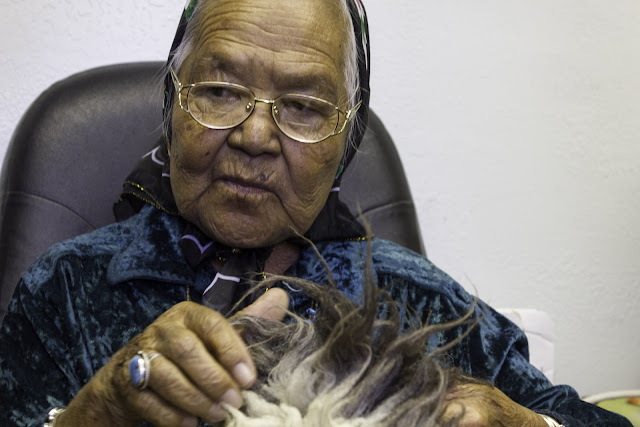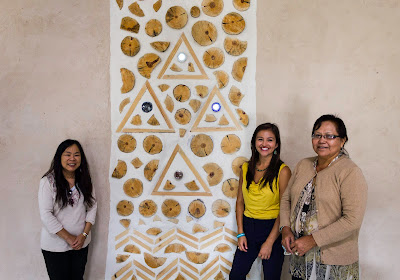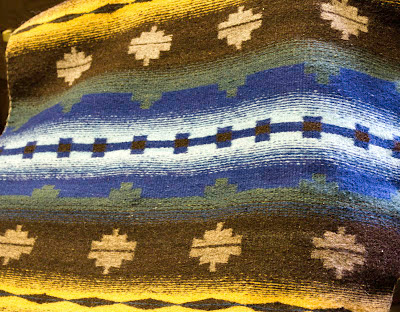Ramah Navajo Weavers Sustain Ancient Connections
This story appeared in Indian Country Today in 2012. For more on topics like this, see my book, American Apartheid: The Native American Struggle....
 |
| Above, elder weaver Katie Henio with a Navajo Churro fleece. Below, she presents a weaving to former U.S. Senator Byron Dorgan during his visit to Ramah Navajo. |
Sarah
Henio-Adeky recounted the recent preparations for her daughter’s wedding, as a
granddaughter smiled shyly. “We butchered a sheep and cooked, didn’t we?” asked
Henio-Adeky (at right in photo), a cultural interpreter for the Ramah Navajo Weavers
Association. The little girl nodded, clinging to her grandma’s leg.
We were standing
outside one of two hogans (eight-sided Navajo homes) the association built to
use for meetings and as classrooms that would provide a home-like context for
learning about sheep and the cultural and environmental knowledge that comes
with herding them and using their meat and wool. Squash ripened in a nearby
garden, and later a horned toad (“a protector,” said Henio-Adeky) scampered by.
 Inside the hogan,
a wall (shown here) was decorated from top to bottom with a pattern that represented the
universe, with the stars at the top, the Navajos’ four sacred mountains in the
center and a human being’s lifelong path marked out across the bottom with
footsteps between paired zigzags, signifying lightning.
Inside the hogan,
a wall (shown here) was decorated from top to bottom with a pattern that represented the
universe, with the stars at the top, the Navajos’ four sacred mountains in the
center and a human being’s lifelong path marked out across the bottom with
footsteps between paired zigzags, signifying lightning.
The weavers’
group, headquartered in the Ramah Navajo’s capital in Pine Hill, New Mexico, is
working to ensure a future in which caring for sheep remains central to life, said
Yin-May Lee (at right in photo) an organizer who’s lived in the Ramah Navajo homeland and worked
with the association since it started in 1984. That means passing on both the
practice of weaving and the values it represents, she said.
Over the years,
the association has also worked with the Ramah Navajo School Board, a powerful
force behind the semi-autonomous community’s long-time local control over its
education, health and political matters. The collaboration has been “a big
plus” for the association, said Sarah’s mother, elder weaver Katie Henio.
 Henio felt the schools could do even more to teach Navajo language and culture, but
that laws and policies unfriendly to traditional lifeways restrict them. “The
policies are hovering over our schools,” she said. “But we must pass down this
knowledge.”
Henio felt the schools could do even more to teach Navajo language and culture, but
that laws and policies unfriendly to traditional lifeways restrict them. “The
policies are hovering over our schools,” she said. “But we must pass down this
knowledge.”
The association
is working against time and the waning participation of its older members, said
Henio-Adeky, who mentioned that a stroke has affected one elder’s memory.
Even Henio—the
subject of Katie Henio, Navajo
Sheepherder, a 1995 biography that celebrated the complex skills needed to
sustain her traditional life—is doing less. “I can only advise at this point,” said
Henio, who’s in her eighties.
The
association’s weavers use two kinds of wool, said Lee. One is from a heritage
breed, the hardy, long-legged Navajo Churro, descendants of animals the Spanish
introduced to this continent during the 16th century. Navajos prize Churros
for their fine-textured, almost sweet-tasting meat, as well as their thick-layered
fleece, with its downy undercoat and long, durable outer fibers. The other wool
source is the heavy-set Rambouillet, a Merino type with short, soft fleece that
was bred by France’s Louis XVI and eventually arrived this country in the 1800s.
 Navajo Churros,
and their herders, have survived holocausts, including Spanish and U.S.
colonization. During the nation’s mid-19th-century western
expansion, a U.S. Army scorched-earth campaign against the Navajo began with
the slaughter of their sheep and other livestock and the burning of homes and
crops. Tribal members were then rounded up for the lethal 1864 Long Walk and
four years of incarceration.
Navajo Churros,
and their herders, have survived holocausts, including Spanish and U.S.
colonization. During the nation’s mid-19th-century western
expansion, a U.S. Army scorched-earth campaign against the Navajo began with
the slaughter of their sheep and other livestock and the burning of homes and
crops. Tribal members were then rounded up for the lethal 1864 Long Walk and
four years of incarceration.
During the
1930s, the federal government decided Navajo ranges were overgrazed and tribal
members’ herds must be smaller. A chaotic stock-reduction program ensued.
Government agents shot and slashed the throats of hundreds of thousands of
Navajo sheep and other animals. They beat up and jailed protesting tribal
members. In the end, the program had disrupted the sheepherders’ careful
stewardship of the desert ecology and decimated their self-sufficient pastoral
economy.
Recreating a
viable land-based economy has been a struggle ever since. When Henio was
younger, she recalled, weavers would barter their virtuosic and time-consuming work
for groceries at area trading posts. Nowadays, the weavers are discussing
value-added products, including processed wool, yarn or meat.
Typically the
smaller weavings sell best, said Lee. “People tend not buy the larger
ones. But no matter the size, the weavings continue to convey of messages of
harmony, beauty and balance, the core of Navajo philosophy, and represent the
history and world of the Navajo people. The four natural colors represent the
four sacred mountains, the dyes come from the land, and the use of the Churro
wool is itself part of the story of rebuilding the relationship between the people
and the land.”
 Henio said she
wasn’t impressed by much of what she hears in the name of development these
days. She described a local radio program on the future of the Navajo economy: “What
I heard wasn’t good planning. They talked about using our nation’s invested
monies to finance short-term projects, with the result being luxury living. No
one listens to those of us who know how to live off the land. I’ve lived my
whole life among sheep. My sheep knew me, as did my horses and cattle. And I’m
healthy.”
Henio said she
wasn’t impressed by much of what she hears in the name of development these
days. She described a local radio program on the future of the Navajo economy: “What
I heard wasn’t good planning. They talked about using our nation’s invested
monies to finance short-term projects, with the result being luxury living. No
one listens to those of us who know how to live off the land. I’ve lived my
whole life among sheep. My sheep knew me, as did my horses and cattle. And I’m
healthy.”
In contrast, Henio
sees disorder all around her—from violence and dependence on government
handouts to droughts and unpredictable weather. “The storms are scolding us and
telling us we’re not connected,” she said. “We need people, from youth to
elders, to connect with the environment, as we did when we grazed sheep by the
thousands and knew what plants were good for them. I hope my people will join
me in believing this.”
It’s up to the
people, said Henio-Adeky. “Many come here and ask a lot of questions so they
can help us write grants, but we Navajo people must work things out ourselves, so
our new generations can become the society we need.”
To that end, Henio-Adeky
is drawing up clan and kinship charts. “We have to figure out how we’re all
related in this small Ramah Navajo community, clarify our values and grow from
there.”
Asked Henio, “Who
will go to the horizon, see the world is beautiful, then come back and say, This
is what I saw?”
Find the Weavings
To see or
purchase the work of the Ramah Navajo weavers, contact their association at
505-775-3254.
Text c. Stephanie Woodard; photographs c. Joseph Zummo.

